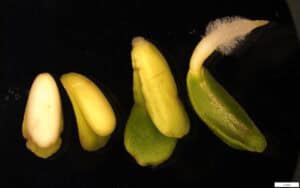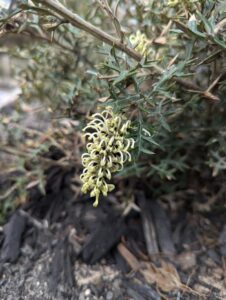
Mar 12, 2025 | News
Grevillea microstegia (Mt Cassell Grevillea) is a critically endangered Victorian endemic found only in the northeastern part of the Grampians around Mt Cassell, accounting for the species’ common name.
As part of the ‘Preventing the extinction of Victoria’s threatened flora’ project funded by the Department of Energy, Environment and Climate Action’s Nature Fund, Royal Botanic Gardens Victoria staff have conducted comprehensive surveys of the species with project partners, whilst simultaneously collecting seeds for long-term banking, tissue samples for genetic analysis, and cuttings for ex situ cultivation.
Seeds of the Mt Cassell Grevillea are difficult to collect in large quantities owing to low yields, and even more challenging to germinate. Recently, Victorian Conservation Seedbank staff successfully germinated this species in the lab setting by fully removing the seed coat, allowing them to document the germination process.

Germinating plants – Credit: Robert Hare
Whilst more labor intensive than the heat or chemical batch-treatments required by other hard-to-germinate species, manual seed coat removal is straightforward if fiddly! This significant development will help us to more effectively conserve the Mt Cassell Grevillea and support future restoration efforts.

Image showing manual seed coat removal – Credit: Hongxiang Zhang
Main image: Grevillea microstegia – Credit: Noushka Reiter
The ‘Preventing the extinction of Victoria’s threatened flora’ project is led by Royal Botanic Gardens Victoria in partnership with La Trobe University, Australian Network for Plant Conservation, DEECA, Parks Victoria, Trust for Nature, Wimmera Catchment Management Authority, Nillumbik Shire, ENVITE, Bairnsdale & District Field Naturalists Club, Friends of the Grampians Gariwerd, WAMA Botanic Gardens, Halls Gap Botanic Gardens, and the Australasian Native Orchid Society Victorian Branch.

Dec 13, 2024 | News
As part of the The ‘Preventing the extinction of Victoria’s threatened flora’ project, horticulturists and scientist have been surveying for, collecting seed, and propagating the critically endangered Grevillea pachylostyla (Buchan River grevillea). These collections will form the basis of an insurance collection and seed orcharding program, safeguarding the future of this species. This elusive, sprawling shrub is known only from deep chasms and steep rocky outcrops in some of Victoria’s most remote alpine areas, making conservation efforts challenging.
This species can now be found in Royal Botanic Gardens Victoria’s conservation collections. The species’ conflorescences (compound flower stems) are cream coloured and gradually change colour to pinkish red as each individual flower reaches anthesis (opening).
Grevillea pachylostyla can be seen flowering now in the Research Garden and Stringybark Garden beds at Cranbourne Gardens—get in before it’s too late!


This research is funded by Department of Energy, Environment and Climate Action‘s Nature Fund.
The ‘Preventing the extinction of Victoria’s threatened flora’ project is led by Royal Botanic Gardens Victoria in partnership with La Trobe University, Australian Network for Plant Conservation, DEECA, Trust for Nature, Wimmera Catchment Management Authority, Nillumbik Shire, ENVITE, Bairnsdale & District Field Naturalists Club, Friends of the Grampians Gariwerd, WAMA Botanic Gardens, Halls Gap Botanic Gardens and the Australasian Native Orchid Society Victorian Branch.
Images Credit: Matthew Henderson

Jul 4, 2024 | News
Less than 40 plants of the Critically Endangered Caladenia ancylosa (Genoa spider orchid) remain in two populations in the wild.
Royal Botanic Gardens Victoria (RBGV) scientists have been growing more than 200 seedlings this year from seed collected post the 2020 mega fires. Seed has been grown symbiotically with mycorrhizal fungi which is required for germination.
RBGV and La Trobe University Scientists this Spring will be doing pollinator studies, to locate suitable sites for future translocations and unravel any pollinator sharing that may occur with closely related species. Surveys for this species are planned in East Gippsland this Spring as part of the ‘Preventing the extinction of Victoria’s threatened flora project’ led by Royal Botanic Gardens Victoria.

Caladenia ancylosa seeds – Credit: Noushka Reiter
This research is funded by Department of Energy, Environment and Climate Action‘s Nature Fund.
The ‘Preventing the extinction of Victoria’s threatened flora’ project is led by Royal Botanic Gardens Victoria in partnership with La Trobe University, Australian Network for Plant Conservation, DEECA, Trust for Nature, Wimmera Catchment Management Authority, Nillumbik Shire, ENVITE, Bairnsdale & District Field Naturalists Club, Friends of the Grampians Gariwerd, WAMA Botanic Gardens, Halls Gap Botanic Gardens and the Australasian Native Orchid Society Victorian Branch.
Feature image – Credit: Noushka Reiter

Jan 29, 2024 | News
Royal Botanic Gardens Victoria and La Trobe University scientists are working hard to protect the Critically Endangered Sphaerolobium acanthos (Grampians Globe-pea).
Growing up to 1 m tall, this spiny shrub has vibrant flowers that are bright orange, but can range from yellow to red in colour.

Sphaerolobium acanthos is restricted with less than 200 individuals remaining in the Gariwerd National Park in Victoria. As part of ongoing conservation work, populations of S. acanthos are being surveyed with genetic studies underway to inform seed collections and propagation for future reintroduction.
The species is thought to be pollinated by native bees, and pollinator studies are helping to establish exactly what these pollinators are so that suitable reintroduction sites can be found to save the plant from extinction.
The Grampians Globe-pea is threatened by animal browsing, habitat loss, and dieback caused by the pathogen Phytophthora cinnamomi (Cinnamon fungus).

This research is funded by Department of Energy, Environment and Climate Action‘s Nature Fund. The ‘Preventing the extinction of Victoria’s threatened flora’ project is led by Royal Botanic Gardens Victoria in partnership with La Trobe University, Australian Network for Plant Conservation, DEECA, Trust for Nature, Wimmera Catchment Management Authority, Nillumbik Shire, ENVITE, Bairnsdale & District Field Naturalists Club, Friends of the Grampians Gariwerd, WAMA Botanic Gardens, Halls Gap Botanic Gardens and the Australasian Native Orchid Society Victorian Branch.
Images supplied by La Trobe University

Jan 5, 2024 | News
Xerochrysum palustre (The Swamp Everlasting)
This beautiful golden everlasting daisy is endemic to south-eastern Australia (https://vicflora.rbg.vic.gov.au/flora/taxon/xerochrysum_palustre). It grows in seasonal or permanent wetlands and swamps scattered from near Portland in western Victoria to Bairnsdale in the east, also occurring in NSW and Tasmania. It is perennial, grows 30-100 cm tall and has showy flowers up to 5 cm across which appear from November to March. It dies off in late summer, and resprouts in winter-spring, depending on rain. The Swamp Everlasting is listed as Critically Endangered under Victoria’s Flora and Fauna Guarantee Act 1988, and as Vulnerable under the Commonwealth Environment Protection and Biodiversity Conservation Act 1999 reflecting a range of threats to the long-term persistence of populations, including land clearing, altered hydrology, weed invasion and grazing.

- Flower seeding – Supplied RBGV
The National Recovery Plan for Xerochrysum palustre (2011) estimated that there were 35 wild populations remaining. With the passage of time and following a recent revision of the genus (see Collins et al. 2022. Australian Systematic Botany 35, 120-185) which reclassified some alpine populations as a new species, Xerochrysum andrewiae, the current number and extent of populations of X. palustre is unclear. It is also difficult to estimate the number of plants and health of populations because of its rhizomatous growth form. As part of the ‘Preventing the extinction of Victoria’s threatened flora’ project, RBGV staff are conducting surveys across its range and collecting material for genetic analysis to characterise diversity in remnant populations. Seeds are also being collected which will be used to grow plants to bolster populations, and act as insurance collections for long-term storage in the Victorian Conservation Seedbank at RBGV, Melbourne.

- RBGV volunteer assisting with seed collection – Supplied RBGV
This research is funded by DEECA Victoria’s Nature Fund. The ‘Preventing the extinction of Victoria’s threatened flora’ project is led by Royal Botanic Gardens Victoria in partnership with La Trobe University, Australian Network for Plant Conservation, DEECA, Trust for Nature, ENVITE, Bairnsdale & District Field Naturalists Club, Friends of the Grampians Gariwerd, Wimmera CMA, Nillumbik Shire, Halls Gap Botanic Gardens and the Australasian Native Orchid Society Victorian Branch.
Feature image: Xerochrysum palustre (supplied RBGV)














